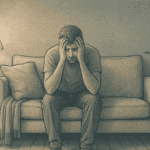Religious and Existential Mental Breakdowns: Coping With a Crisis of Belief

Some of the most important questions we have about life, death, meaning, and purpose don’t have real answers. For some people, religion fills that gap. It gives structure, offers explanations, and helps people feel less alone in the chaos.
But for many, those answers eventually stop making sense. Perhaps the explanations offered by the belief system don’t hold up under closer scrutiny, or they fail to satisfy a deeper intellectual or emotional need. As a result, the belief system collapses, and with it, the person’s sense of identity and reality.
This article aims to get to the root of what a crisis of faith is and how to cope with it by covering:
- What existential and religious breakdowns are
- Potential causes of crises of faith
- How to recognize the signs of a spiritual crisis
- The differences between a spiritual awakening and a mental breakdown
- How a loss of faith can affect mental health
- When an existential nervous breakdown becomes a mental health emergency
- Coping strategies for an existential nervous breakdown

Understanding Existential and Religious Breakdowns
According to Erik Erikson’s psychosocial development theory, identity formation is a central task of adolescence and early adulthood. And for many, religion plays a critical role in shaping that identity.1
This is why questioning religion feels like losing the ground beneath your feet. When you begin to ask, “What if I don’t believe this anymore?”, the follow-up questions can come uninvited and relentlessly. For instance…
Who am I?
What do I believe now?
What happens to everything I thought was true?
Such questions can hit you with the force of grief. People going through religious breakdowns often describe it as a form of mourning. Mourning not only for mental health and loss of belief, but for the version of themselves that existed inside that belief.
Potential Triggers Behind a Crisis of Belief
People typically don’t just wake up one day and suddenly decide that their faith no longer makes sense. More often, it’s a slow burn ignited by specific moments and questions that start to pull at the edges of their spiritual world. However, certain events or situations can set off these questions. The following sections cover potential triggers behind crises of belief.
Suffering That Doesn’t Make Sense
When the pain hits raw and unfair, the theological frameworks someone leans on for comfort start to collapse.Thoughts that once brought peace feel inadequate in the face of your lived experience. For instance, you begin asking, Why would a loving God allow this?
Clashing Morality
For example, someone raised to believe that certain people are inherently sinful may find that belief crumbling in the face of respect for those individuals. Or, a survivor of abuse may struggle with teachings that urge forgiveness without accountability.
Such conflicts can force someone into impossible choices between staying loyal to their tradition or staying true to their sense of what is good and just.
Intellectual Dissonance
Sometimes, a crisis emerges with learning. For instance, it can begin with a quiet moment in a lecture hall or a late-night Wikipedia rabbit hole that plants a seed of doubt. Someone may not even realize it at first, but the lens through which they saw the world starts to blur.
More often, it is not done with malicious intent. In fact, many people begin these explorations as deeply committed believers, simply wanting to deepen their understanding of their faith. But the more they learn, the more they realize that the story they were taught may not be the only one.
For instance, discovering that the sacred texts you were told were divinely dictated were, in fact, compiled over centuries and translated through layers of political context can be very unsettling.
When Religious Institutions and Leaders Cause Harm
Nothing shatters faith faster than watching people who claim to represent a belief system do the exact opposite of what they preach. It could be a trusted religious figure who abuses power, or a community that preaches compassion but acts with cruelty or exclusion, for example.
When those who claim to represent truth and morality act immorally, it can feel like betrayal. The result is not just disillusionment with the person or institution but with the entire framework they represent. Someone may start to wonder if the belief system itself is flawed or corrupt at its core.
Recognizing the Signs of a Spiritual Crisis
Here are some clear religious breakdown symptoms that indicate you may be in the thick of a real spiritual crisis and emotional collapse:
- Feeling a growing sense that life has no meaning, and the beliefs that once grounded you now seem empty
- Finding yourself disillusioned with your belief system
- Experiencing persistent emotional distress like anxiety, restlessness, or sadness
- Pulling away from your faith community or spiritual practices because they no longer feel nourishing
- Starting to obsessively question everything about God, truth, death, and morality, and not finding satisfying answers
- Feeling guilty about doubts, as if even asking the questions makes you a bad person
- Noticing a strong desire to deconstruct your beliefs or to rebuild something truer from scratch
- Catching yourself thinking that you’re “going through the motions”
- Feeling alone in your experience, like those around you would reject you if you said your doubts out loud
How to Tell the Difference Between a Spiritual Awakening and a Mental Breakdown
Both spiritual awakenings and mental breakdowns can involve intense emotion, disorientation, crying, existential questions, and even panic.
But there are a few important differences that can help you tell them apart.
In a mental breakdown, you might feel like you’re losing yourself completely. For instance, your thoughts may be chaotic. You might stop sleeping or eating and struggle to function in ways that used to be automatic. Like not getting out of bed, refusing to talk to people, and no longer brushing your teeth. And beneath all these issues, there might be the fear that something is seriously wrong with you.
Like a mental breakdown, a spiritual awakening can be quite overwhelming – but there’s a strange clarity beneath its chaos. You may feel like your old beliefs, identity, and sense of purpose are shifting inside you. But instead of complete collapse, you feel like something real is trying to emerge. You’re not disconnected from reality; you’re seeing it with new eyes, even if that view is unsettling.
People in the middle of a spiritual awakening often feel misunderstood, but they usually want to make sense of what’s happening. They’re seeking. They can reflect. But in a breakdown, insight typically becomes harder, and people might withdraw completely or stop caring.
It’s not always either/or. Sometimes a breakdown opens the door to awakening. Similarly, an awakening can stir up unresolved trauma or mental illness.
How Loss of Faith Affects Mental Health
Faith also engages the ventromedial prefrontal cortex and temporoparietal junction, which help people process meaning, intention, and empathy.
However, when belief is lost, these neural networks destabilize because the brain suddenly has no script for interpreting suffering, mortality, or moral ambiguity.
The emotional impact of religious questioning is increased anxiety and intrusive thoughts. In fact, people undergoing religious disaffiliation often experience symptoms that resemble grief and trauma. For instance, a study found that former believers had significantly higher rates of rumination and depressive symptoms compared to active believers.5
Religion also comes with community, rituals, and identity, and loss of belief can mean losing all three at once. This is demonstrated in research showing that ex-members of high-commitment religious groups reported intense loneliness and faith-based identity loss after leaving their religion.6
When Does an Existential Nervous Breakdown Become a Mental Health Emergency?
Functional impairment: If you can’t get out of bed, maintain hygiene, eat properly, or keep up with work or relationships, what you’re going through could be a disabling mental health condition.
- Suicidal ideation: When existential despair shifts into hopelessness and thoughts like Life is pointless, Nothing matters, or I want to stop existing, acute intervention is likely needed. In fact, studies show that a perceived lack of meaning in life is one of the strongest psychological predictors of suicidal thinking.7
- Psychotic features: In some cases, existential breakdown triggers psychosis. A psychotic break can look like someone seeming detached from reality. The DSM-5 classifies persistent dissociation, especially when it impairs identity and time perception, as a mental disorder requiring treatment.8
- Loss of cognitive anchoring: This can happen when someone starts losing their grip on time or self to the point that they can’t orient themselves in daily life. For instance, people sometimes report a collapse of identity, which, if not stabilized, can lead to identity disturbances seen in borderline or dissociative disorders.
Coping Strategies for Existential Nervous Breakdown
Like any other mental health issue, religious and existential breakdowns require evidence-based interventions, including the following options.
Mindfulness-Based Stress Reduction (MBSR)
MBSR works by training the brain to observe existential thoughts without being pulled into panic. It strengthens the brain’s executive control networks (like the prefrontal cortex) and helps people tolerate uncertainty, a core trigger in existential breakdowns.
Re-Establishing Routine
An existential breakdown activates the sympathetic nervous system (fight or flight response). As a result, people may experience hypervigilance, insomnia, and emotional flooding.
Physical routines can send safety signals to the brain, reducing existential anxiety by shifting activation from threat-focused brain systems to emotion regulation circuits.
Routines you could put in place for coping with religious disillusionment include:
- Sleep hygiene: Poor sleep amplifies negative moods, but a sleep routine can help balance the emotional and physical system
- Exercise: Aerobic activity increases brain-derived neurotrophic factor, which supports neural resilience during identity crises
- Cold exposure or deep breathing: These stimulate the vagus nerve, which calms the fight-or-flight response
Rebuilding Social Anchors and Narrative Identity
Losing a belief system can also cause loss of community, rituals, and a sense of place in the world. In short, it can dismantle your narrative identity.
Yet humans are biologically wired for meaning through connection. Belonging to a group provides cognitive scaffolding and gives a language, rhythm, and reference points for rebuilding identity.
In a supportive environment, like in a support group or trusted relationships, you can rebuild your narrative identity piece by piece. Therefore, people recovering from religious disaffiliation may rebuild identity faster and more coherently when they have strong social ties.
Therapy for Religious Trauma and Existential Breakdown
In cases of religious trauma, people often struggle with guilt, shame, fear of punishment, or black-and-white moral thinking long after they’ve left a belief system. These rigid thought patterns are cognitive distortions, but they can be challenged directly through CBT for existential breakdown recovery.
In CBT, you track the fear-based thoughts that come with an existential crisis in real-time or by using a thought log. Then, once a thought is identified, you learn to challenge it. After exposing the distortion, you learn to reframe it to develop a more balanced version.
Additionally, CBT also involves developing coping tools like breathing techniques, grounding exercises, and routines that regulate your emotional response when existential dread or religious triggers arise.
Over time, CBT strengthens your prefrontal cortex’s control over fear responses and weakens rigid, threat-based thought loops. It builds psychological flexibility, so even if you’re still uncertain about life’s big questions, you’re no longer paralyzed by them.
Heal From Faith and Existential Nervous Breakdowns at Mission Connection
At Mission Connection, CBT is at the heart of how we support mental health recovery. Our licensed therapists use research-backed CBT methods tailored to your existential and faith challenges and help you make measurable progress, session by session.
If you’re stuck in cycles of fear about divine punishment, haunted by spiritual guilt, or feel emotionally paralyzed after losing your faith, our team can help you in healing from a crisis of faith.
Call us today or get started online to get in touch with a mental health professional at Mission Connection.

References
- McLeod, S. (2025, April 18). Erik Erikson’s stages of psychosocial development. Simply Psychology. https://www.simplypsychology.org/Erik-Erikson.html
- Park, C. L., Silverman, E. J., Sacco, S. J., Kim, D., Hall, M. E. L., McMartin, J., Kapic, K., Shannonhouse, L., David, A. B., & Aten, J. (2023). When suffering contradicts belief: Measuring theodical struggling. Current Psychology. https://doi.org/10.1007/s12144-023-04642-w
- McKay, R., & Whitehouse, H. (2019). Religion and morality. Psychological Bulletin, 141(2), 447–473. https://doi.org/10.1037/a0038455
- McNamara, P., & Grafman, J. (2024). Advances in brain and religion studies: A review and synthesis of recent representative studies. Frontiers in Human Neuroscience, 18. https://doi.org/10.3389/fnhum.2024.1495565
- Bonelli, R., Dew, R. E., Koenig, H. G., Rosmarin, D. H., & Vasegh, S. (2012). Religious and spiritual factors in depression: Review and integration of the research. Depression Research and Treatment, 2012, 1–8. https://doi.org/10.1155/2012/962860
- Fenelon, A., & Danielsen, S. (2016). Leaving my religion: Understanding the relationship between religious disaffiliation, health, and well-being. Social Science Research, 57(57), 49–62. https://doi.org/10.1016/j.ssresearch.2016.01.007
- Guo, Z., Yang, T., He, Y., Tian, W., Wang, C., Zhang, Y., Liu, J., Liu, X., Zhu, X., & Wu, S. (2023). The relationships between suicidal ideation, meaning in life, and affect: A network analysis. International Journal of Mental Health and Addiction. https://doi.org/10.1007/s11469-023-01019-9
- Schmeck, K., Schlüter-Müller, S., Foelsch, P. A., & Doering, S. (2013). The role of identity in the DSM-5 classification of personality disorders. Child and Adolescent Psychiatry and Mental Health, 7(1), 27. https://doi.org/10.1186/1753-2000-7-27
- Kabat-Zinn, J. (2003). Mindfulness-based interventions in context: Past, present, and future. Clinical Psychology: Science and Practice, 10(2), 145. https://doi.org/10.1093/clipsy.bpg016
- de Abreu Costa, M., & Moreira-Almeida, A. (2021). Religion-adapted cognitive behavioral therapy: A review and description of techniques. Journal of Religion and Health, 61(1), 443–466. https://doi.org/10.1007/s10943-021-01345-z






